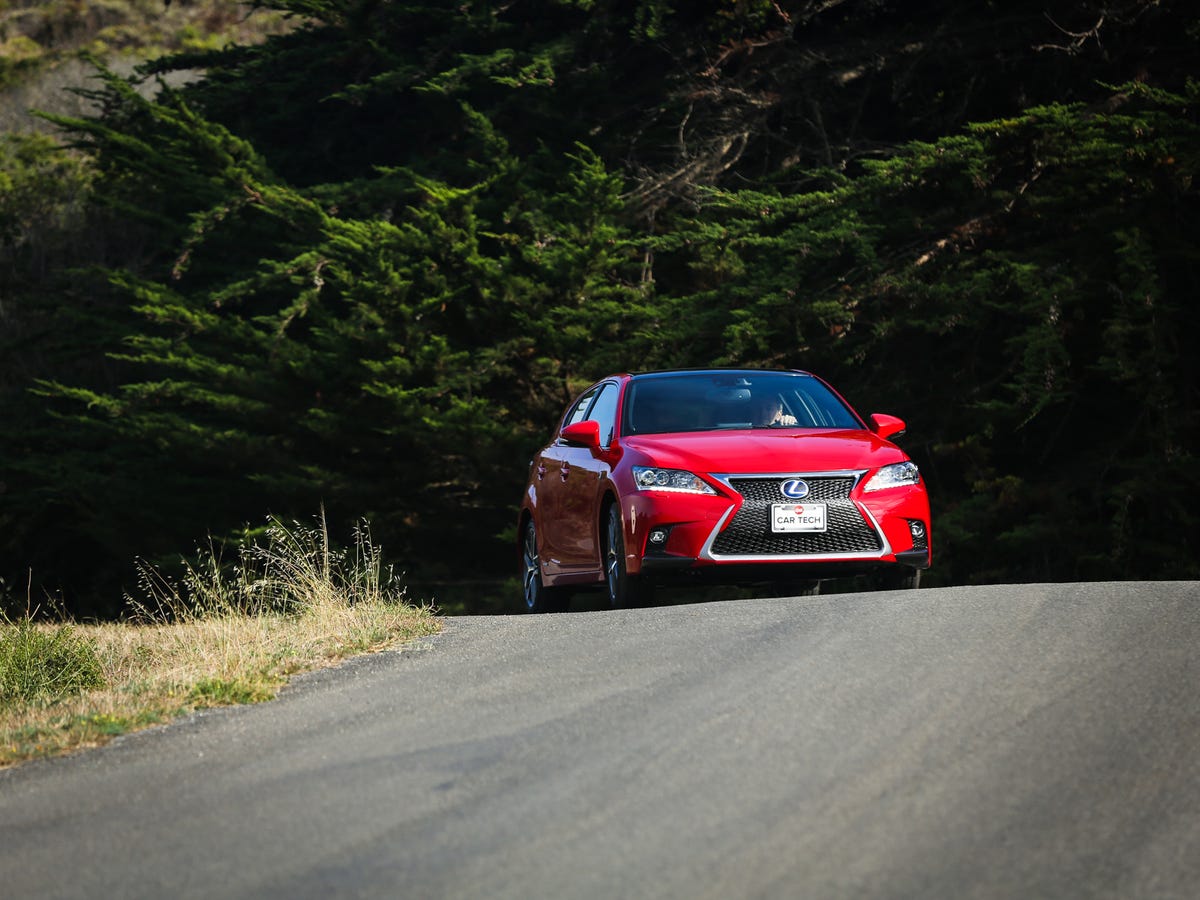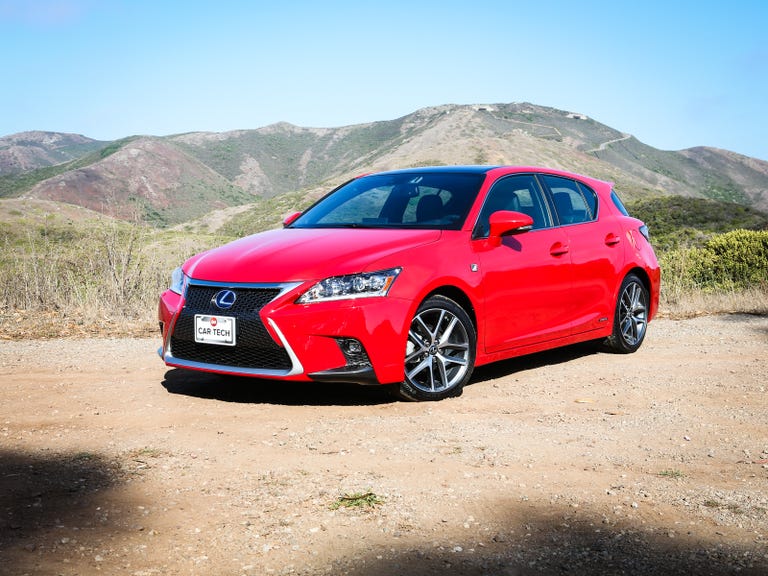 Why You Can Trust CNET
Why You Can Trust CNET 2014 Lexus CT 200h review: Lexus CT 200h looks fast, goes slow, and saves gas
In F Sport trim, the new Lexus CT 200h looks like a hot hatchback, but an anemic driveline focuses on fuel economy.
Despite many advances in engine efficiency, the tussle between power versus fuel economy remains alive and well. For today's example, the 2014 Lexus CT 200h, fitted with F Sport performance improvements, achieves extraordinary fuel economy but drives like a slug.
The Good
The Bad
The Bottom Line
The CT 200h is an odd duck, not only as the entry-level Lexus model, but also as a dedicated hatchback and hybrid. It joins the ES , RX , and all-new NX as front-wheel-drive architecture cars in the Lexus line-up. In the US, the base price comes in at only $32,050, rock-bottom for a premium segment car, but adding navigation, the F Sport Luxury package, and F Sport LED headlights took my example up to $41,815 with destination. The CT 200h's driveline remains the same for UK and Australian buyers, although option packs will vary. The UK base price comes in at £20,995 while Australians will pay AU$45,751. Unfortunately, CO2 emissions of 82 g/km won't exempt the CT 200h from London congestion charges.
I have always liked the hatchback styling of the CT 200h, and the 2014 model, which received a design update, looked excellent in its Redline exterior color. Really setting off this example was the F Sport package, which added a slick spoiler above the hatch and a black roof, nicely offsetting the red body. 17-inch five-spoke alloy wheels completed the look.
Inside, Lexus fitted the 2014 CT 200h with its Remote Touch controller, an omnidirectional puck that controls a cursor on the center LCD. I'm not crazy about this controller, as I find it too easy to miss the button I'm trying to hit. However, amid the Lexus-standard cabin tech software, I was pleased to find smart improvements, such as new voice command over apps and better feature organization. Interior design and materials rose to the level of luxury you would expect from a Lexus, making this cabin a nice place to sit.
Despite a sporty exterior design, Lexus fits the CT 200h with essentially the same driveline as the Toyota Prius, a 1.8-liter four-cylinder engine aided by a 60-kilowatt electric motor, with a total output of 134 horsepower. At 3,130 pounds curb weight, that means a zero to 60 mph time of 9.8 seconds, according to Lexus' numbers. On the flip side, 43 mpg in the city and 40 mpg on the highway will take you very far on a tank of gasoline. I achieved 41.3 mpg for a driving course that included freeway travel and flooring it around mountain curves.

Light it up
As with most hybrids, hitting the CT 200h's start button lit up the instrument cluster and the center LCD, but let the engine rest until it was actually needed. The 7-inch LCD in the new CT 200h copies a modern design trend by protruding from the top of the dashboard, as if it were a flat screen on top of an entertainment center. Expecting the typical Lexus software to which I have become accustomed, I was delighted to see new, high-resolution maps. In perspective view, these showed 3D rendered buildings in downtown San Francisco, helpful for matching outside location to the virtual world of the map.
The three all-important controllers occupying the center stack and console were the drive selector, drive mode selector, and the Remote Touch puck. The drive selector offers the usual drive and reverse positions, and a B position that tells the driveline to maximize braking regeneration. There was a single button for Park along with an emergency brake lever. The drive mode selector, a dial on the console, let me choose Sport, Normal, or Eco modes. each affecting the throttle response.
Deciding that my first outing should focus on efficiency, I twisted the dial to Eco and took off. Well, "take off" may be too dramatic in describing the very gradual acceleration. I can understand detuning the throttle to mitigate a lead foot, but I practically had to floor the gas pedal to make the CT 200h move in this mode. The throttle response was, I felt, too anemic. Later, when driving on the freeway in Eco mode, I found it difficult to maintain 65 mph. The car seemed to always want to drop 10 mph off my intended speed.
Moving to Normal drive mode, the instrument cluster illumination went from green to blue and the throttle became more tractable. That's not to say it felt powerful, but at least the CT 200h could get out of its own way. One trick that helped initial acceleration was the electric motor integrated into the drivetrain. Its instant torque added a little pep to my starts. The hybrid drivetrain worked brilliantly, bringing up the engine as needed and wasting almost no gasoline for idling. The transmission, a planetary gearset that mixes power from the engine and motor to drive the front wheels, works completely seamlessly, so that I never felt different power sources taking over. Likewise, Lexus does a fine job insulating the cabin from engine noise, so there's very little disturbance when the engine cranks up.
In Normal mode, I drove the CT 200h up steep San Francisco hills and hurtled it down the freeway. The hybrid system is particularly adept at handling slow traffic, making the creep and crawl of a traffic jam tolerable.
Another thing Lexus does extremely well is tune comfortable suspensions. F Sport in the CT 200h means the suspension is tuned for handling, but that doesn't wreck the ride quality. Over rough city streets, the car absorbed bumps and kept cabin jostling to a minimum. It felt superior in quality over a typical hatchback, helping to justify its premium segment pricing. At the same time, the steering wheel, controlling an electric power-steering system, felt responsive. The car matched my inputs neatly, and the wheel offered enough heft for a natural feel.
App excellence
As an aid to my meanderings in the CT 200h, the navigation system performed very well, showing the worst traffic jams and providing easy-to-follow route guidance. For destination input, voice command was as modern as they come, letting me say an entire street address and processing it correctly. But where Lexus cabin tech really shines is with its Enform app suite. With my phone running the Enform app and connected to the car through Bluetooth, I could choose "Web Search" as one of my destination options and select either Bing or Yelp, both online services built into the car. Instead of burying these services under an Apps menu, as in other Lexus vehicles, they live in the destination menu.
I was really blown away to find that, using the voice-command button on the steering wheel, I could use voice to start destination searches in Bing and Yelp. Beyond these two apps, Enform offered iHeartRadio, Pandora, MovieTickets.com, OpenTable, and Facebook Places, with voice command available for the lot. I was also impressed to find the music apps located on the audio-sources screen for the stereo. Lexus has been doing some really good work here.
As for other audio options, the CT 200h ran the usual gamut. Two USB ports in the console were a nice touch, letting me plug in my phone and a USB drive. However, the shallow recess for the ports meant the cover had to remain open. Bluetooth streaming, satellite radio, and HD radio rounded out the sources. The base stereo for the CT 200h is a 6-speaker rig, but this one came with the upgraded 10-speaker system. I found the audio quality very good, with very enjoyable overall reproduction, but nothing to make me shiver.
Power down
I've put off writing about sport driving, as it was disappointing. Turning the dial to Sport mode draped the instrument cluster in a red mist and changed the power gauge to a proper tachometer. However, monitoring engine speed isn't very useful when you can't shift. The throttle more easily brought power to bear, but it was far from ferocious. The real let-down when trying to flog the CT 200h through a set of turns was that its power was constantly caught short. It could not bring power up fast enough to get out of a turn, and there were no virtual gears or other means by which I could control the power output.
And that was a shame, because the F Sport tuning was good. When I could get the CT 200h moving at some speed through a turn, I could feel a lot of handling potential. Although the dampers were soft enough to create a comfortable ride experience, they didn't stretch too much in the turns, while the responsive steering made the car feel nimble, like it really wanted to be thrown into corner after corner.
All together
The F Sport trim on the 2014 Lexus CT 200h makes it something of a sheep in a wolf's pelt. I was very impressed by the styling of this car, especially how the spoiler extended the roofline and the black roof contrasted with the red exterior. The new spindle grille, a Lexus design cue, works well on the CT 200h, and the hatchback affords practicality.
The fuel economy is fantastic -- I can't think of another car with comparable premium appointments and comfortable ride quality that can average over 40 mpg. But the price is power, something very lacking in the CT 200h. I would love to see Lexus pump the horsepower to 200 by fitting it with the drivetrain from the Toyota Camry Hybrid, and I expect the fuel economy would still average in the mid-30s.
Lexus hits all the right marks with the CT 200h's cabin tech, and I particularly like the new maps in the navigation system. The audio sources and Bluetooth phone functions met all my expectations. But moving the CT 200h beyond the ordinary are the connected services offered with Enform. From what I'm seeing in this improved implementation, Lexus looks like it has one of the most usable app-integration systems of any automaker.
Wayne's comparable picks
| Tech specs | |
| Model | 2014 Lexus CT 200h |
| Powertrain | 1.8-liter gasoline-electric hybrid system, continuously variable transmission |
| EPA fuel economy | 43 mpg city/40 mpg highway |
| Observed fuel economy | 41.3 mpg |
| Navigation | Optional with live traffic |
| Bluetooth phone support | Standard |
| Digital audio sources | Internet streaming, Bluetooth streaming, USB drive, iOS integration, HD radio, satellite radio |
| Audio system | 10-speaker system |
| Driver aids | Rear view camera |
| Base price | $32,050 |
| Price as tested | $41,815 |


